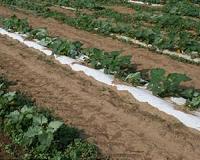 |
Storrs CT (SPX) Jan 04, 2011 Woody ornamental plants with colorful or unusually shaped stems, buds, flowers, or fruits represent a growing specialty niche in cut flower production markets. These unique plants can be good prospects for off-season production, offering distinct benefits such as extended growing seasons, respectable financial returns, hardiness, and the ability to produce multiple harvests from single plantings. A research team from the Department of Plant Science and Landscape Architecture at the University of Connecticut recently published the results of a poll of North American willow "cut stem" producers. The study was designed to identify willow growers' profiles, production acreages, and gross sales, to evaluate consistency in production practices, and to assess the prospective market value for crop expansion. According to Yulia A. Kuzovkina, corresponding author of the study, the potential exists to significantly expand the consumer market for woody cut stems, but until recently "woody floral crops have received little formal research attention to determine the best cultural practices for optimal yields". Willow is among the most popular woody plant used in cut stem production operations; species and varieties exhibit a range of unique ornamental attributes, including showy catkins, brightly colored stems, and contorted, or "fasciated", stems. Willows are typically harvested during the late winter months when few plants are available for field production in temperate climates. Cash returns for willow growers can range from $1.25-1.75 per stem for species harvested for ornamental catkins, and annual gross financial returns for willow plants-reported at up to $24.94 per plant-are much higher than for many other woody florals. The team distributed a survey to willow growers throughout North America. The survey included questions concerning business identity and cultural practices, including plant spacing, fertilization, irrigation, and pruning methods. Survey responses confirmed that willow was a supplemental source of income for most growers, complementing a larger product selection of woody and herbaceous species for cut flower production. The majority of growers expressed the importance of including willow in their product selection and noted a desire to increase production acreage and extend seasonal markets. The responses also revealed what the research team refers to as "the nonscientific nature of willow production", evidenced by growers' wide variations in basic cultural practices, limited use of scientific plant names, and frequent inability to accurately identify their selections. "This survey can help researchers to identify a set of questions to improve the understanding of the fundamentals of willow production through the development of precise commercial production practices, standardization of variety names, and stimulation of further development of this crop through market expansion", noted Kuzovkina.
Share This Article With Planet Earth
Related Links American Society for Horticultural Science Farming Today - Suppliers and Technology
 Paper Mulches Evaluated For Commercial Vegetable Production
Paper Mulches Evaluated For Commercial Vegetable ProductionLexington KY (SPX) Jan 04, 2011 Polyethylene mulches, used widely in commercial vegetable production to improve crop yields and produce quality, have distinct disadvantages. Disposal options are limited, and plastic mulches often end up in landfills, being burned, or disposed of illegally. Recycling polyethylene mulches is also a challenge; the mulches used in large-scale vegetable production are contaminated with too mu ... read more |
|
| The content herein, unless otherwise known to be public domain, are Copyright 1995-2010 - SpaceDaily. AFP and UPI Wire Stories are copyright Agence France-Presse and United Press International. ESA Portal Reports are copyright European Space Agency. All NASA sourced material is public domain. Additional copyrights may apply in whole or part to other bona fide parties. Advertising does not imply endorsement,agreement or approval of any opinions, statements or information provided by SpaceDaily on any Web page published or hosted by SpaceDaily. Privacy Statement |